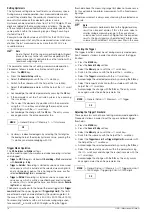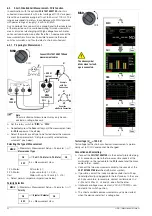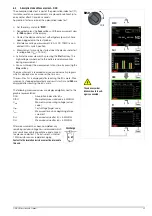
GMC-I Messtechnik GmbH
31
6.7
Resistance Measurement “
”
➭
Disconnect supply power from the electrical circuit of the de-
vice to be measured, and discharge all high-voltage capaci-
tors.
➭
Make sure that the device under test is voltage-free. Interfer-
ence voltages distort measurement results!
Refer to Chapter 6.6.4 regarding testing for the absence of
voltage with the help of the direct voltage measurement.
➭
Set the rotary switch to “
”.
➭
Repeatedly press the
Func
softkey until the “
” measuring
function is displayed.
➭
If necessary, conduct zero balancing by pressing the
Zero
key
(see description below).
➭
Connect the device under test as shown.
➭
Measurement is started immediately.
Note
Use short or shielded measurement cables in the case of
high-impedance resistance.
Improving Accuracy by means of Zero Balancing – Zero
Cable resistance and contact resistance can be eliminated in all
measuring ranges by means of zero balancing.
➭
Short circuit the measurement cables to this end.
➭
Press the
Zero
softkey.
➭
Insofar as the value for
Zero
is less than a permissible threshold
of 0 to 50% of the measuring range, the
Zero
softkey is no lon-
ger grayed out in the display and the
Zero
function can be acti-
vated by pressing the
Zero
key.
➭
The value ascertained for
Zero
is saved and appears above the
measurement display. Automatic compensation of cable resis-
tance is activated for all subsequent measurements.
➭
The value for Zero is retained when the instrument is switched
to a different measuring function. The correction or offset value
is deleted by pressing
Zero
once again, or when the instrument
is switched off. The value is cleared from the display.
Note
The “Setup for currently selected measurement” sub-
menu cannot be accessed for the resistance measure-
ment because no further settings are provided for.
S–
A
V
Temp
m
/4
COIL
S+
Func
Temp
Func
Func
Func
F
Temp. RTD
TEMP TC
300
/3 k
/30 k
Measuring ranges:
300 k
/3 M
/30 M
R
x
0 V!
!
R
x
Zero






























